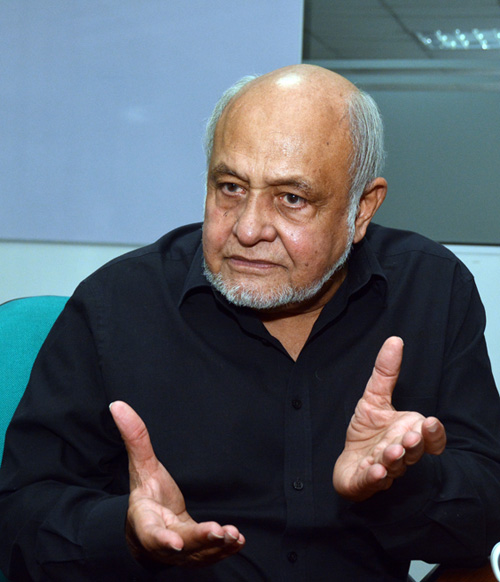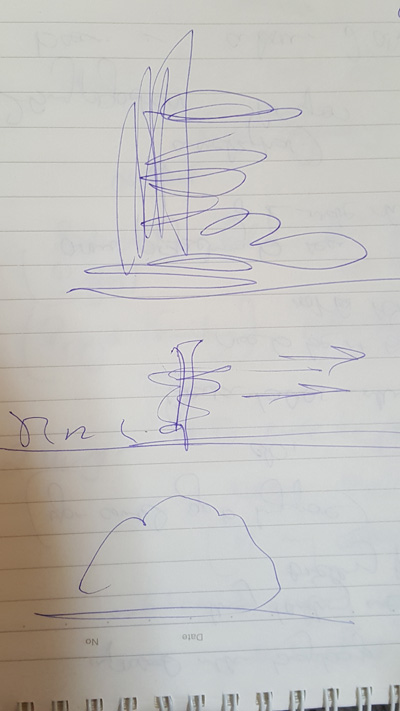Infinity and beyond with Balmond and Cinnamon Life
COLOMBO – Cecil Balmond has borrowed my pen. I’m watching the master at work, bent over my reporter’s notebook, as he sketches the initial drawing which was the blueprint for the ‘iconic’ Cinnamon Life landmark which is set to transform Colombo by 2020.

Cecil Balmond. Pic by M.D. Nissanka
In a previous story I had written on this project for this newspaper, more than a year ago, I learned that the world-renowned architect had sketched his vision on a paper napkin after visiting the site for the first time back in 2011.
“I can’t remember, but it must be true, for I tend to do very small drawings at the beginning when I imagine something,” smiles Balmond when I ask him if the story of the genesis of Cinnamon Life is true.
The Sri Lankan-born Balmond, 75, is on one of his regular visits to Colombo now that the project is up-and-running and unfolding with plenty of fizz at the former Elephant House site. He has taken time off a busy schedule to have a chat with the Sunday Times at the Glennie Street site office on Wednesday.
Balmond was awarded an OBE by the Queen in 2015 and is based in London.
He is so busy that he hasn’t had time for lunch – it is 3.30 pm – and is wolfing down vegetable sandwiches and egg boats, the type his Burgher community used to make for parties. I join him for a quick bite before we get down to business – first-up drawing the sketch of the plan on my notebook.
I notice he doesn’t lift the nib of the pen off the page until the drawing is done. It is one fluid and dynamic work. It looks like a scribble to my untrained eye and my Philistine mind. But this drawing has spawned a creation which will deliver the main terms of the brief given by John Keells – give us an iconic landmark.
Iconic building
“In my contract, John Keells had asked for an iconic building for Sri Lanka. This was in my mind when I first saw the site. I walked around for nearly two hours with my son. We walked everywhere imagining what it would be like, for at that time there was no Shangri-La, or trying to imagine what it would be like overlooking the Taj,” Balmond revealed.
“The company has huge ambitions. I was very impressed with what they wanted. The more I met the senior management – Susantha Ratnayake, Ajit Gunawardene, Suresh Rajendra and others – I was very impressed with these people and I thought to myself I needed to do a good job to realise their ambitions.
“They were trusting me to make something special and that is a very powerful thing for an architect to know that a client wants something special. You could go to Singapore and get many designers to do simple towers but this was an ambitious project. This was at the back of my mind when I took that first walk on the site.”
Balmond has something in common with the JKH top table – they had all gone to the same school, Royal College, although he says he is “an old boy of Trinity.” His father, H.J. Balmond was the Registrar of the University of Ceylon, but when he moved to the University of Peradeniya, Cecil left and boarded at Trinity College. “But I’m a Royal Old Boy when I’m with the John Keells’ crowd,” he laughs.
This unseen bond was the perfect glue for both parties as the plan to create a living and work space, a 20,000 square metre retail Mecca, an entertainment hub, and of course not forgetting the 800-room hotel, was being forged seven years ago.

The Balmond sketch on the notebook.
Although not bordering the sea-front, the site fronted a large reservoir of water, the Beira Lake, and this was another factor which Balmond had to incorporate into his plan on that walkabout. He says he went into a trance. At this point I’m so transfixed by the man, who looks just like any other Burgher uncle who always had a wonderful story to relate, that I’m not the least bit surprised by this disclosure.
“You are on the site, you walk the site and I put myself into some kind of a meditation. You have to forget everything around you, just focus internally. It’s an art, its instinct, and all my work is like that. Every site has a unique stamp which comes from being there. I don’t have any overall style, or any mandate on what to do. I let it evolve, and I just think what will I do.”
Infinite
Inspired, he came up with one word that would be the buzzword for the entire project – Infinite. “The first sketch I did for the Board of directors was showing two arms projecting to the sea, and I wrote the word ‘Infinite’ below it. In my mind it was a metaphor for an open-ended ambition, not just for John Keells, but also for the country. I wanted Sri Lanka to project an image, a world-class image.”
Many years after he left then-Ceylon armed with a degree in civil engineering from Colombo University, Balmond on one of his visits back home was invited to give the annual Geoffrey Bawa lecture. By then, June, 2010, the war had been over a year. Peace had returned.
“There were more than a 1,000 people in the huge auditorium at Ananda College. “I remember telling the audience that what I wanted to see as a Sri Lankan was to open an architectural book and see a story written about a project in Sri Lanka. When I read architectural magazines, it is always about projects somewhere else. I told the architects in the audience that I wanted to see Sri Lanka on the world map of architecture.”
A year later, he gets a call from Ajit Gunawardene, the former deputy chairman of JKH, now retired, asking if he would be interested in building an ‘iconic’ building for the company. By now Balmond was an established figure in the world of architecture. His buildings were dotted around the globe, becoming the talking point of the public.
The CCTV headquarters in Beijing, “probably the most advanced building in the world,’ the towering ArcelorMittal Orbit sculpture in London to mark the 2012 Olympics, the Serpentine Pavilion in the UK to name a few of the 40 projects worldwide, had propelled Balmond into world-class grade.
“It was a call from out of the blue,” says Balmond, who didn’t envisage that he would get the opportunity to do something, create a Sri Lankan masterpiece, something he had once urged young architects at the Ananda College auditorium to achieve.
Dutch ancestry
Balmond’s mother was a Herft of Dutch ancestry. His father’s side was English. His great-grandfather was an Englishman who came to Ceylon to work in the Railways. His grandfather was born in Ceylon, marrying an Irishwoman. Growing up in Borella, his first love was music – playing the guitar in a band – and reading came a close second. These twin muses brewed the creative juices inside him.
But he never thought he would return to work in the country of his birth after leaving in the 1950s. That was until fate played a hand – during the 2004 Tsunami on Boxing Day, his entire family were holidaying in Trincomalee and were on the beach in Nilaveli when tragedy struck.
“I thought that was the end. It is amazing that we all survived. We got swept out and I thought I had lost my youngest son and daughter. But the tsunami was what pulled me back to Sri Lanka. My family and I saw the compassion of the people of this country. It touched my children who were foreign in a sense as they had never lived here. My eldest son said he wanted to come back and live in Sri Lanka.”
Deeply moved by the empathy shown by strangers to those affected by the tsunami, Balmond offered to do pro bono work and designed two universities in the East of the country. Cinnamon Life is his first major project, although he also did the showroom office at Port City.
“I like reading what the ancient people did. I spend a lot of time reading old mythology. Old stories, even the Buddha Jataka stories. Human beings basically worked with narrative, we told stories to each other and buildings have to tell stories. When you go in and go out, it is like entering a book, reading its plots, feeling its characters. A memorable book you keep in your head, similarly a memorable building.”
So what story will this building on the Beira tell? Balmond grins. It reminds him of one of his most loved projects – the Coimbra footbridge in Portugal where the two halves are offset against each other and doesn’t look like it will meet in the middle. After building this classic he discovered that the people of the area thought he had been inspired by a famous love story set in the 14th Century between a King and the Queen’s lady-in-waiting. It ended in tragedy with the commoner being murdered.
The lovers never met like the two sides of the bridge.
“The Mayor of that town thought I knew the story and that’s why I had designed the bridge that way. Sometimes things just happen like that. I called it serendipity. Who knows, maybe there is a story buried somewhere in the old Elephant House,” Balmond smiles.
Who knows. Fate has its ways. Just ask the prodigal son who returned home to build an iconic building after a tsunami had spared his family.
| Cinnamon Life Cinnamon Life is envisioned to be the epicentre of modern South-east Asia offering an urban escape into world-class hospitality, entertainment and lifestyle. This iconic project designed by Cecil Balmond will be a city within a city, and will consist of the following;
| |


